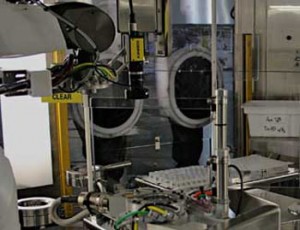Vision technology brings flexibility to life sciences
 When Automated Systems of Tacoma (AST) was asked by a life science research company to develop an alternative to conventional pharmaceutical filling machinery having the capability to fill and finish all their small-scale clinical trial products with a single flexible platform, it turned to Cognex for a vision solution.
When Automated Systems of Tacoma (AST) was asked by a life science research company to develop an alternative to conventional pharmaceutical filling machinery having the capability to fill and finish all their small-scale clinical trial products with a single flexible platform, it turned to Cognex for a vision solution.
Machines that are typically used to fill vials, syringes and other containers for pharmaceutical manufacturers rely on dedicated machinery having hard automation. Since most automated filling systems rely on exact positioning unique to each container size and type, filling different container formats requires the manufacturer to purchase multiple filling machines, or tolerate lengthy changeovers when switching between container types. To increase the flexibility offered in this conventional approach, AST needed to develop a machine with the able to handle various sizes of prefilled syringes, vials, cartridges and IV bags with minimal product changeover times.
The basic concept is a system that positions ready-to-use “nests” of a particular container within the operating envelopes of two robots, the Cognex In-Sight Micro vision system is used to precisely locate each container and stopper and provide the robots these locations prior to processing. This approach allows for rapid changeover from one container type or size to another by loading a new robot program, replacing the products carriers, and instructing the robot to change out the end of arm tooling. The system’s use of disposable materials is used on all process contacting parts which also reduces the changeover time, and eliminates the risk of cross contamination.
Integration of vision and robotics is critical
The biggest challenge of developing a machine that embodies these concepts is integrating the robot and vision system in order to provide the high levels of accuracy and speed required by the application. AST called in Brian LaFave of Olympus Controls because of his company’s long experience in developing vision applications. “I took a close look at the application and came to the conclusion that integration between the vision system and robot was key” Lafave said. “Mounting the vision system on the robot arm also made it essential for the vision system to be small, light and have very simple cabling. I felt that the Cognex Micro In-Sight 1100 would be perfect for the task.”
The Cognex In-Sight Micro system comes equipped with preconfigured drivers, ready to use templates, and sample code for communicating with most robots. The Staubli TX-60 HE six axis industrial robot was AST’s first choice for this application, because of its ability to withstand aggressive cleaning and bio-decontamination required for the application.
“The robotic filling system is the simplest solution for any organisation looking to increase their product and container filling capabilities, without purchasing multiple machines dedicated to a particular product or container type,” said Josh Russell, Project Engineer for the Life Sciences Group at AST. “The machine is capable of handling all liquid packaging needs for many pharmaceutical companies, contract manufacturers and compounding pharmacies at hospitals. It fits within a 12 by 16 foot cleanroom and costs far less than the machines that it replaces.”
Visit the Cognex website for more information
See all stories for Cognex















